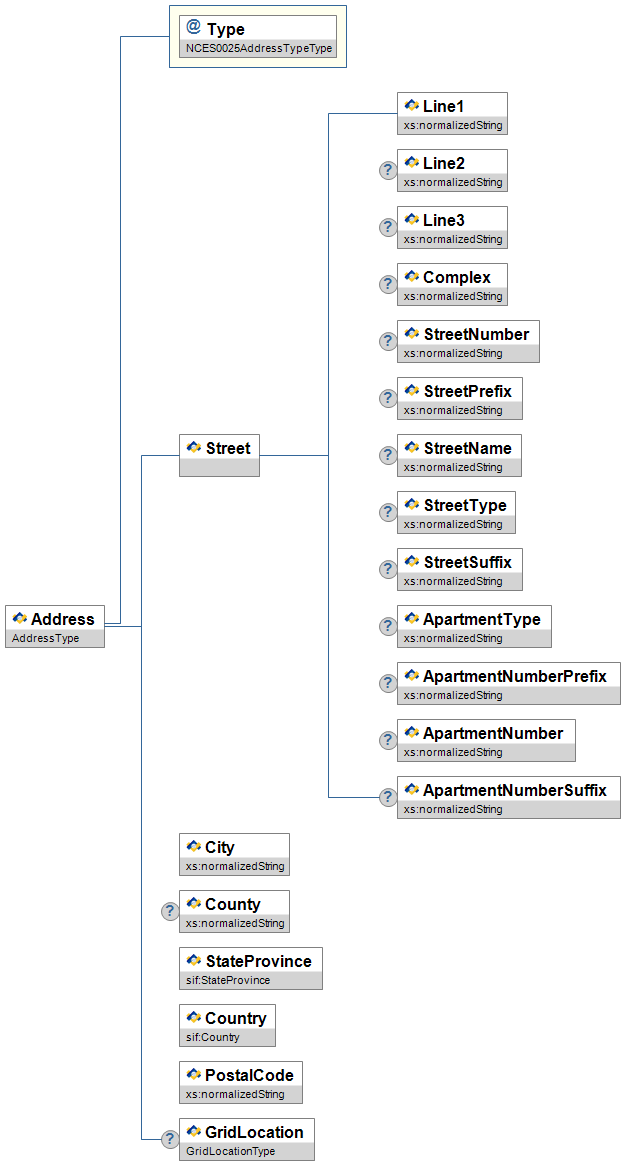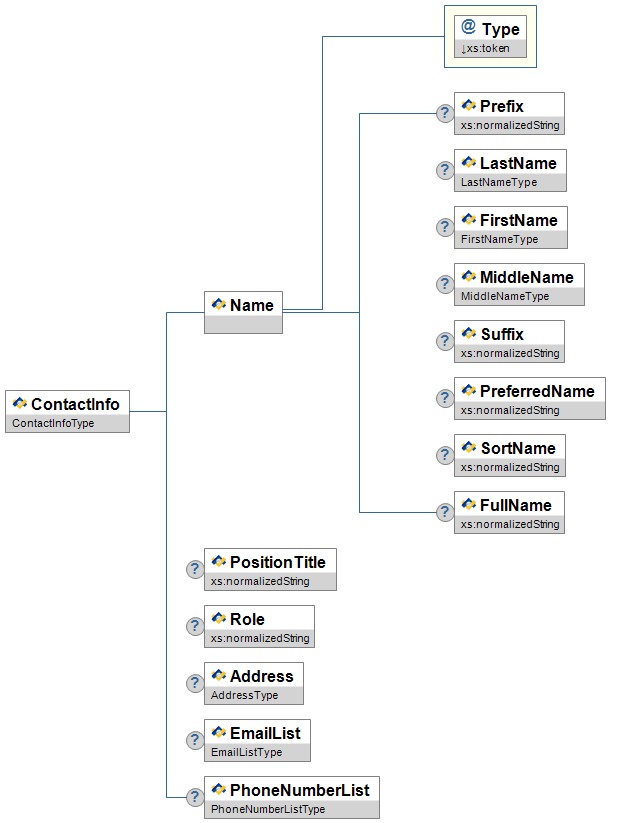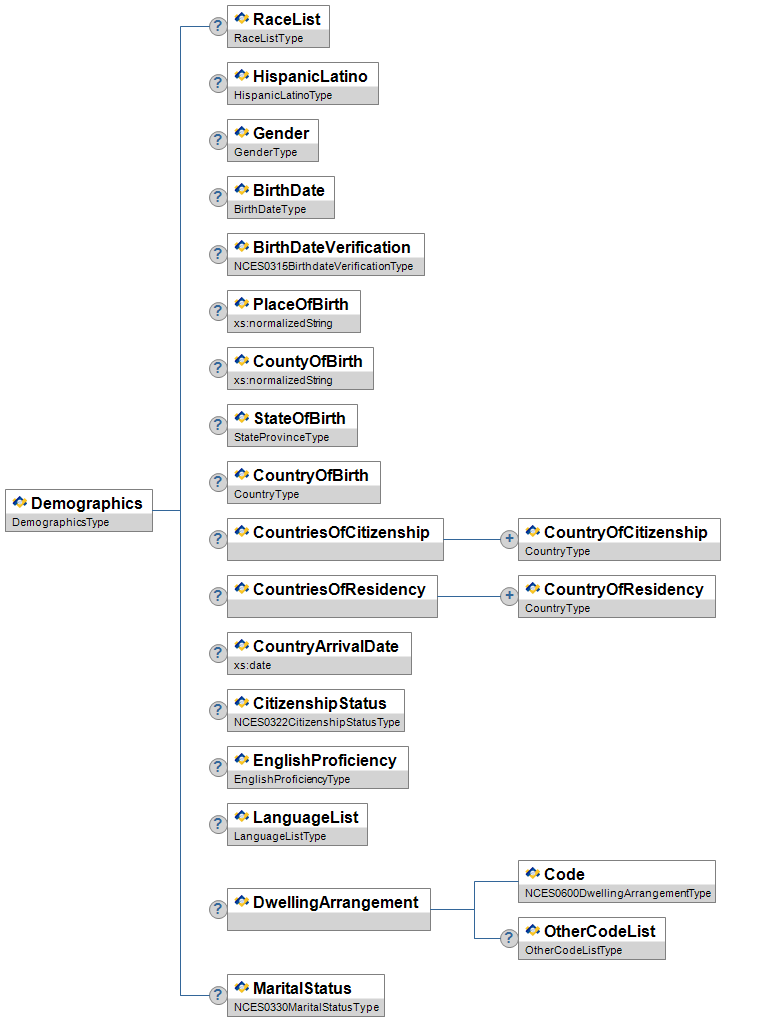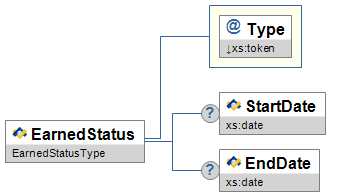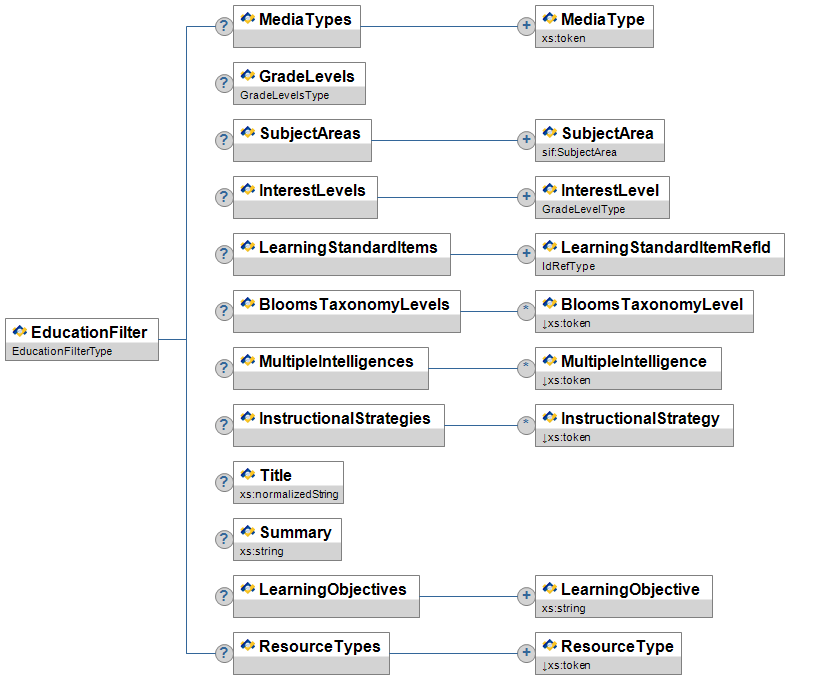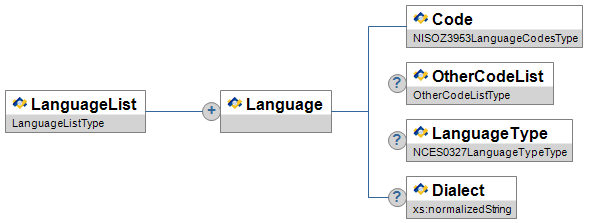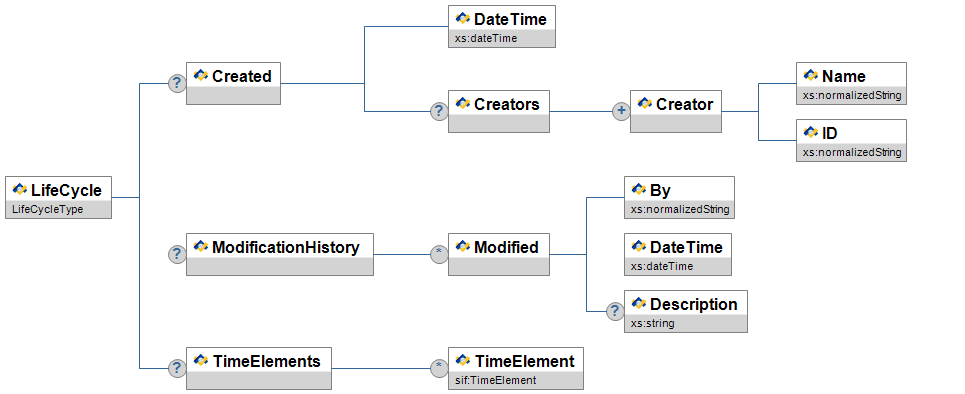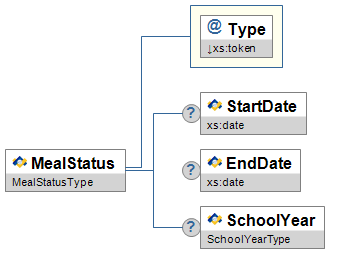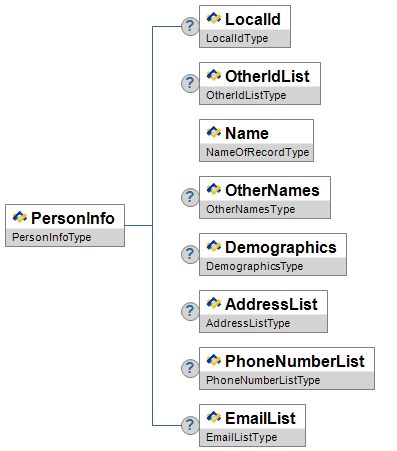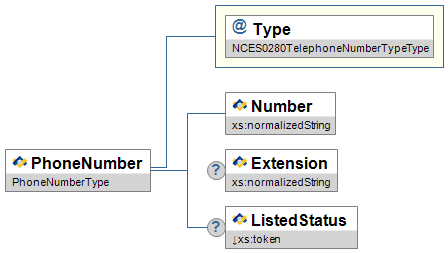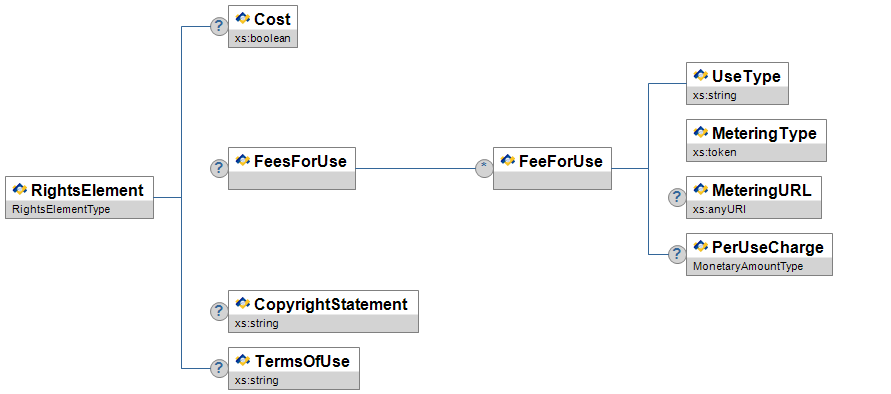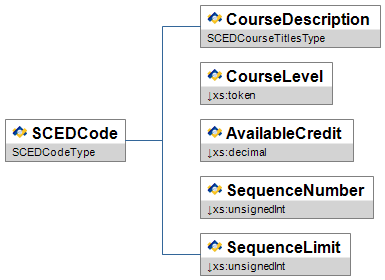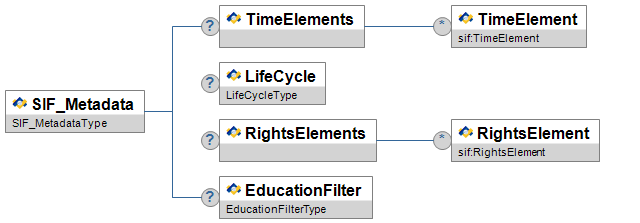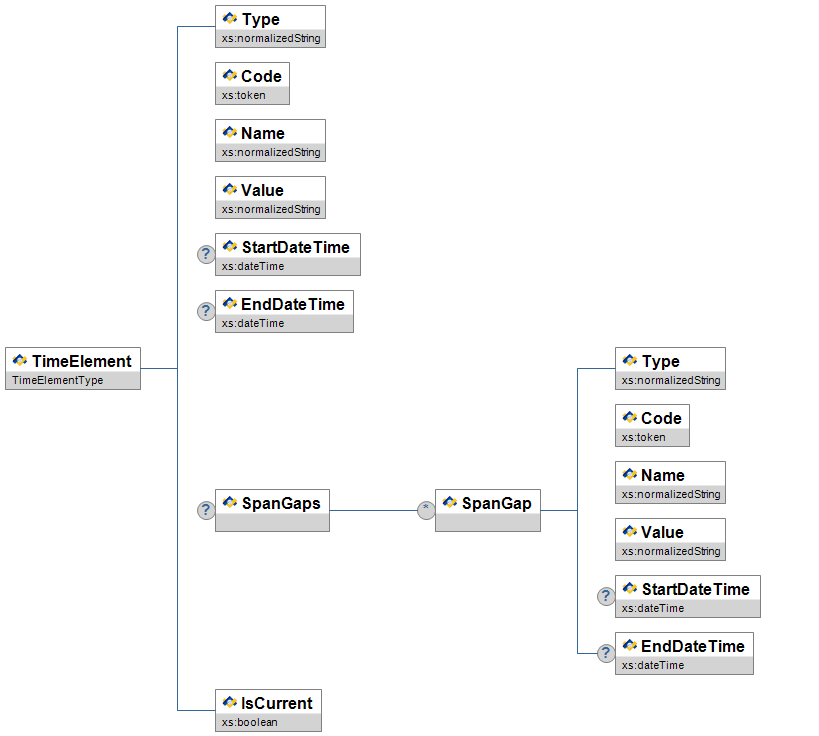6 Data Model
6.1 Introduction
This section presents the XML structure for SIF Data Model common elements and objects in a tabular format for readers
less versed in parsing formal XML schema definitions, along with conventions that typically apply in the data model for
easy reference.
6.1.1 Format
The Char(acteristics) column for all of the tables in this section use the following codes:
| Code |
Characteristic |
| M |
Mandatory element or attribute |
| O |
Optional element or attribute |
| C |
Conditional element or attribute |
| MR |
Mandatory and repeatable element |
| OR |
Optional and repeatable element |
| CR |
Conditional and repeatable element |
Mandatory elements MUST be present in Add events, and
in non-empty and non-error responses to requests for entire SIF objects (e.g., no SIF_Query/SIF_QueryObject/SIF_Element elements supplied in the request).
Mandatory attributes MUST always be present if their corresponding element is present.
SIF Agents and Zone Integration Servers MUST supply data according to the types specified in the Type columns and their corresponding equivalents
in the most recent schema files associated with this specification. If there is a discrepancy between object and element definitions in this specification and the
corresponding schema files,
the definition in the schema files takes precedence; every effort will be made to note discrepancies in the errata for this document as they
are identified.
6.1.2 Conventions
6.1.2.1 Object Attributes/Primary Keys
XML attributes in SIF are primarily used to provide additional information regarding the associated element content. In addition, attributes at the root level of an object can have special significance. These root-level attributes often serve as the primary key or identifier for the object. In many cases this is no more than a RefId GUID of RefIdType, though these object key components may consist solely of foreign key references to other SIF objects and include school years, dates, etc. These object key components (root-level attributes) are immutable over the lifetime of an object and serve the purpose of uniquely identifying an object, especially in Change and Delete events. Some Working Groups also include non-object key components in object attributes: e.g., mandatory foreign key references to other objects or attributes that provide additional processing information regarding the object. As SIF currently does not mandate that all object attributes be included in all messages, when a SIF Association Working Group or Task Force places a non-primary key attribute
in the object's attribute definitions (typically out of historical query conventions), they are indicating that this value must still be accessible
to systems in Change and, more notably, Delete events. Also, all object key component attributes must be supplied to identify the object
in Change and Delete events.
6.1.2.2 Object References
As stated elsewhere, SIF primarily uses GUIDs as object identifiers, primary keys, or RefIds. References to primary keys (foreign key references)
follow certain conventions in SIF in most objects:
-
An element or attribute of type
IdRefType can be defined that consists of the referenced object name
concatenated with RefId, e.g.,
StudentPersonalRefId
(a reference to the object identifier/primary key/RefId
of a
StudentPersonal
object);
-
An element requiring a more descriptive name for the reference or one that refers to more than one object type is defined as
IdRefType, has an element name of a group's choosing (or generically SIF_RefId) and enumerates all possible object types that can be referenced
in the SIF_RefObject attribute; or
-
A pair of attributes can be defined, one of type
IdRefType containing the referenced object's RefId, the other enumerating
all possible object types that can be referenced; generically these are named SIF_RefId and SIF_RefObject, respectively;
naming conventions that programmatically allow identification of the pair beyond the generic names will be documented when the need arises.
6.1.2.3 Lists/Repeatable Elements
For those accustomed to normalized relational databases, the SIF Data Model will appear to be not especially normalized, especially with regard to
repeating groups of data not separated into their own "tables," or in SIF's case, "objects" with primary/foreign keys to maintain the
relationship. Bear in mind that SIF is not a format for storing
data; it is a format for transmitting data asynchronously between disparate and distributed systems needing to share data for
interoperability; the format this data takes in different systems can vary greatly, and the data related to any given "entity" may
come from a variety of sources and systems.
The goals of normalization—eliminating redundancy, organizing data efficiently, reducing inconsistencies, etc.—take on a different meaning in
a message queuing system. Of primary importance is transmitting the data needed for interoperability in a minimum number of messages. The need to "join" together
a great number of separate objects is kept to a minimum in SIF, as individual systems do not have access to all the data required and due to the asynchronous
nature of SIF, any one of these systems may take a fair amount of time before returning data necessary for joins (SIF_ExtendedQuery has been
developed to communicate a join to a single system that may have direct access to the all the data necessary to efficiently accomplish this task). It's one
thing to make a separate request for a student's picture or enrollment information, another entirely to request every available phone number, address and e-mail
address separately from the SIF Zone. As such, it is often the case in SIF that repeating data is stored directly in an object, rather than being separated
out into a separate object.
Repeating data is very analogous to objects, though, within any given object. In SIF's Publish/Subscribe model, repeating elements in objects
can be added to, changed in or deleted from an object, much like objects can be added to, changed in or deleted from a Zone. Within an existing object, all of these
actions take place within a Change event, and repeating elements—if any exist initially—are first made available within an object in an Add
event or can be obtained directly via requests. Repeatable elements are contained within a parent List element in most SIF objects
whether or not they support events, e.g.:
<EmailList>
<Email Type="Primary">contact@sifinfo.org</Email>
<Email Type="Alternate1">info@sifinfo.org</Email>
</EmailList>
Example 6.1.2.3-1: EmailList
Two types of list are currently defined in SIF, ActionList and List; both consist of a list container element and a single repeatable
child element. Each type of list serves different needs and has associated conventions for communication and processing in the SIF Publish/Subscribe Model.
List or ActionList is specified in the Type column in tables in this section for each list; when an ActionList the key, possibly
compound, is also indicated in the Type column. ActionList key values must be unique within an instance of an ActionList.
6.1.2.3.1 ActionList
An ActionList has a key that uniquely identifies each child element within the list. This type of list is primarily used when it is
desirable or necessary for systems to support or refer to a subset of the list, either due to functionally only being able to support a subset
or because specifying a subset in Change events is more efficient than transmitting a whole list as in List.
While one system may support the
Primary
and
Alternate1
e-mail address types above, another may additionally support
Alternate2
addresses.
The second system
is able to communicate the addition, change or deletion of an
Alternate2
address without
the first system inadvertently interpreting
that to mean a student or staff member's
Primary
and
Alternate1
addresses have been deleted.
Systems communicate the whole list as a cohesive unit consisting of the parent list container element and all child elements in an Add
event; if the container is present with no child elements, the list is empty; the same is implied when an optional list is not present in an
Add event. In a Change event, systems SHOULD only transmit those elements that have been added, changed or deleted. Deletion
is not implied by the omission of a child element, but rather explicitly communicated with a SIF_Action attribute of Delete
added to the deleted element, along with the element's key attribute(s)/element(s) at a minimum. An empty list in a Change event implies
no changes have occurred in the list, as does the omission of the list. Systems storing ActionList data should set/replace/delete any
existing values identified by primary keys in the Change event they support.
<EmailList>
<Email Type="Primary">editor@sifinfo.org</Email>
<Email Type="Alternate1" SIF_Action="Delete" />
</EmailList>
Example 6.1.2.3.1-1: Indicating a new value for the Primary e-mail address and deleting the Alternate1 address
A system that supports an
Alternate2
e-mail makes no changes to its value for that address type.
6.1.2.3.2 List
While a unique, primary key may still be identifiable in its child elements, a List is used primarily when:
- the list is a cohesive whole conceptually, where supporting or referring to a subset of the list is of little value;
- when the list consists only of keys, and no associated data;
- the list is informational/temporary state information and not typically persisted; or
- when no key exists to uniquely identify items in the list.
Lists are always transmitted as a cohesive unit consisting of the parent list container element and all child elements. If no child
elements exist in the list, the list consists of the container element alone. Omission of an optional List in an Add event
also implies no list items. In a Change event, omission of the List indicates no changes have been made; otherwise the
parent container element and all child elements, if any, are included. Systems storing
List data should replace all corresponding data in their systems when persisting the list; likewise when a change is made to one or more
list items or when all items in the list are deleted, systems should send the whole list in a Change event.
<CountriesOfCitizenship>
<CountryOfCitizenship>US</CountryOfCitizenship>
<CountryOfCitizenship>DE</CountryOfCitizenship>
</CountriesOfCitizenship>
Example 6.1.2.3.2-1: Indicating an updated list of country citizenships
A system that supports CountriesOfCitizenship updates its local data to reflect U.S.
and German citizenship.
6.1.2.4 Supported Optional Elements Without Values
Some agents follow the convention of supplying an optional element as empty (e.g. <BirthDate></BirthDate> or <BirthDate/> to indicate
that the application supports the element, but that it currently has no value available within a given object. To allow for this convention within SIF—as in this example
an empty string does not satisfy the xs:date type definition of BirthDate—all optional elements in SIF
are defined as nillable [SCHEMA]. To satisfy type constraints on an element while still supplying an empty or "nil"
value, agents MUST tag the element with a true value for the nil attribute from namespace
http://www.w3.org/2001/XMLSchema-instance [SCHEMA] (e.g. <BirthDate xsi:nil="true"/> where the prefix xsi has been mapped to
the namespace http://www.w3.org/2001/XMLSchema-instance), unless an empty value is valid with regard to the element's type definition,
in which case supplying the nil attribute value of true is optional.
See SIF and XML Namespaces for more details on namespaces, and SIF and XML Schema
for more details on SIF's use of XML Schema.
6.1.2.5 Externally-Defined XML
Note that XML not defined within SIF does not necessarily support ad hoc omission of XML elements at will to conform with the conventions of the SIF Publish/Subscribe Model
(where unchanged elements are typically omitted in Change events, and where non-key elements are often omitted in Delete events) or of the SIF Request/Response Model
(where a subset of elements can be retrieved from objects with requests). If externally-defined XML occurs within a SIF data object, SIF conventions do not
extend to that XML unless that XML is defined to accommodate SIF conventions; the XML, when transmitted, must only conform to any external definitions dictating
its structure, if any. Applications should be prepared for the possibility of receiving whole externally-defined XML structures in Change events (regardless of how little or much of the external
XML has changed) and possibly also Delete events, likewise in responses even when a subset of the XML structure's child elements may have explicitly been requested.
6.2 Common Elements
6.2.1 Address
This element represents an address. This element occurs within objects and elements such as StaffPersonal and
StudentPersonal/StudentAddress, etc.
Figure 6.2.1-1: AddressTable 6.2.1-1: Address
<Address Type="0123">
<Street>
<Line1>1 IBM Plaza</Line1>
<Line2>Suite 2000</Line2>
<StreetNumber>1</StreetNumber>
<StreetName>IBM</StreetName>
<StreetType>Plaza</StreetType>
<ApartmentType>Suite</ApartmentType>
<ApartmentNumber>2000</ApartmentNumber>
</Street>
<City>Chicago</City>
<County>Cook</County>
<StateProvince>IL</StateProvince>
<Country>US</Country>
<PostalCode>60611</PostalCode>
<GridLocation>
<Latitude>41.850000</Latitude>
<Longitude>-87.650000</Longitude>
</GridLocation>
</Address>
6.2.2 AddressList
A list of Address elements.
Figure 6.2.2-1: AddressList| | Element/@Attribute | Char | Description | Type |
|---|
| | AddressList | | A list of Address elements. | ActionList (Address/@Type) |
| | Address | MR | | Address |
| @ | SIF_Action | O |
In a Change event, this flag can be used to indicate an element has been deleted from the parent list container. At a minimum the key for the list must also be present.
| values:
- Delete
|
Table 6.2.2-1: AddressList
<AddressList>
<Address Type="0123">
<Street>
<Line1>1 IBM Plaza</Line1>
<Line2>Suite 2000</Line2>
<StreetNumber>1</StreetNumber>
<StreetName>IBM</StreetName>
<StreetType>Plaza</StreetType>
<ApartmentType>Suite</ApartmentType>
<ApartmentNumber>2000</ApartmentNumber>
</Street>
<City>Chicago</City>
<County>Cook</County>
<StateProvince>IL</StateProvince>
<Country>US</Country>
<PostalCode>60611</PostalCode>
<GridLocation>
<Latitude>41.850000</Latitude>
<Longitude>-87.650000</Longitude>
</GridLocation>
</Address>
</AddressList>
6.2.3 BirthDate
A person's date of birth.
Figure 6.2.3-1: BirthDate| | Element/@Attribute | Char | Description | Type |
|---|
| | BirthDate | | A person's date of birth. | xs:date |
Table 6.2.3-1: BirthDate
<BirthDate>1970-08-11</BirthDate>
6.2.4 CongressionalDistrict
Common element used to indicate the number of the U.S. Congressional District in which an entity resides or is
physically located.
Figure 6.2.4-1: CongressionalDistrict| | Element/@Attribute | Char | Description | Type |
|---|
| | CongressionalDistrict | |
Number for the US congressional district. While typically numerical, this element does allow for text values to cover exceptions, e.g. to indicate an "at-large"
district as in Wyoming.
| union of:
xs:unsignedInt
xs:token |
Table 6.2.4-1: CongressionalDistrict
<CongressionalDistrict>3</CongressionalDistrict>
6.2.5 ContactInfo
Common element used to supply information for a contact person at a school, LEA, or other institution.
Figure 6.2.5-1: ContactInfo| | Element/@Attribute | Char | Description | Type |
|---|
| | ContactInfo | | Common element used to supply information for a contact person at a school, LEA, or other institution. | |
| | Name | M |
The name of the contact person. Note that Name is redefined here to allow for LastName
and FirstName to be omitted if they cannot be provided; when omitted, FullName must have
a value.
| |
| @ | Type | M |
Code that specifies what type of name this is. If unsure, use 04.
| values:
- 01
- Given Name (Name at Birth)
- 02
- Current Legal
- 03
- Alias
- 04
- Name of Record
- 05
- Previous Name (sometimes called Maiden Name of Female Persons)
- 07
- Married Name
- 08
- Professional Name
|
| | Name/Prefix | O | A prefix associated with the name like Mr., Ms., etc. | xs:normalizedString |
| | Name/LastName | O | The last name. | LastName |
| | Name/FirstName | O | The first name. | FirstName |
| | Name/MiddleName | O | The middle name or initial. | MiddleName |
| | Name/Suffix | O | Generation of suffix like II, Jr., etc. | xs:normalizedString |
| | Name/PreferredName | O | This is a name that the person prefers to be called by. | xs:normalizedString |
| | Name/SortName | O | This is the name to be used for sorting purposes. | xs:normalizedString |
| | Name/FullName | C |
A free text field for the complete name. Mandatory if LastName and FirstName are omitted.
| xs:normalizedString |
| | PositionTitle | O | The contact person's position title. Examples
Superintendent
| xs:normalizedString |
| | Role | O | Role played by this contact in this instance. Examples
Report Contact
Primary Contact
Alternate Contact
| xs:normalizedString |
| | Address | O | Address of the contact. | Address |
| | EmailList | O | List of Email elements. | EmailList |
| | PhoneNumberList | O | List of PhoneNumber elements. | PhoneNumberList |
Table 6.2.5-1: ContactInfo
<ContactInfo>
<Name Type="04">
<LastName>Geisel</LastName>
<FirstName>Theodore</FirstName>
<FullName>Theodore Geisel</FullName>
</Name>
<PositionTitle>Superintendent</PositionTitle>
<EmailList>
<Email Type="Primary">drseuss@whoville.k12.state.us</Email>
</EmailList>
<PhoneNumberList>
<PhoneNumber Type="0096">
<Number>(555) 555-0102</Number>
</PhoneNumber>
</PhoneNumberList>
</ContactInfo>
6.2.6 Country
A country code.
Figure 6.2.6-1: CountryTable 6.2.6-1: Country
Example 6.2.6-1: Country
6.2.7 CourseCode
School-defined local code for a course.
Figure 6.2.7-1: CourseCode| | Element/@Attribute | Char | Description | Type |
|---|
| | CourseCode | | School-defined local code for a course. | xs:normalizedString |
Table 6.2.7-1: CourseCode
<CourseCode>CS101A</CourseCode>
6.2.8 CourseCredits
The number of credits awarded upon course completion.
Figure 6.2.8-1: CourseCreditsTable 6.2.8-1: CourseCredits
<CourseCredits Type="0588">2</CourseCredits>
6.2.9 CourseTitle
Title of a course.
Figure 6.2.9-1: CourseTitleTable 6.2.9-1: CourseTitle
<CourseTitle>Graphics Basics</CourseTitle>
6.2.10 Demographics
Demographics information about the student, contact, staff member, etc. This element occurs within objects such as
StudentPersonal, StudentContact, etc.
Figure 6.2.10-1: Demographics| | Element/@Attribute | Char | Description | Type |
|---|
| | Demographics | |
Demographics information about the student, contact, staff member, etc. This element occurs within objects such as
StudentPersonal, StudentContact, etc.
| |
| | RaceList | O | | RaceList |
| | HispanicLatino | O | | HispanicLatino |
| | Gender | O | Person's gender. | Gender |
| | BirthDate | O | The person's date of birth. | BirthDate |
| | BirthDateVerification | O | Means by which the person's birth date was validated. | NCES0315BirthdateVerificationType |
| | PlaceOfBirth | O | The person's place of birth—like village, town, city etc. | xs:normalizedString |
| | CountyOfBirth | O | The county in which the person was born. | xs:normalizedString |
| | StateOfBirth | O | The person's state of birth. | StateProvince |
| | CountryOfBirth | O | The person's country of birth. | Country |
| | CountriesOfCitizenship | O | | List |
| | CountriesOfCitizenship/CountryOfCitizenship
| MR | A person's country of citizenship. | Country |
| | CountriesOfResidency | O | | List |
| | CountriesOfResidency/CountryOfResidency
| MR | A person's country of residence. | Country |
| | CountryArrivalDate | O | Date the person first arrived in the country. | xs:date |
| | CitizenshipStatus | O | The person's citizenship status. | NCES0322CitizenshipStatusType |
| | EnglishProficiency | O | Person's proficiency in English. | EnglishProficiency |
| | LanguageList | O | List of languages an individual uses to communicate. | LanguageList |
| | DwellingArrangement | O | Setting/environment in which the person resides. | |
| | DwellingArrangement/Code | M | Code representing the setting/environment in which the person resides | NCES0600DwellingArrangementType |
| | DwellingArrangement/OtherCodeList
| O | | OtherCodeList |
| | MaritalStatus | O | The person's marital status. | NCES0330MaritalStatusType |
Table 6.2.10-1: Demographics
<Demographics>
<RaceList>
<Race>
<Code>1002</Code>
</Race>
</RaceList>
<Gender>M</Gender>
<BirthDate>1990-09-26</BirthDate>
<BirthDateVerification>1004</BirthDateVerification>
<PlaceOfBirth>Miami</PlaceOfBirth>
<CountyOfBirth>Dade</CountyOfBirth>
<StateOfBirth>FL</StateOfBirth>
<CountryOfBirth>US</CountryOfBirth>
<CountriesOfCitizenship>
<CountryOfCitizenship>US</CountryOfCitizenship>
</CountriesOfCitizenship>
<CountriesOfResidency>
<CountryOfResidency>US</CountryOfResidency>
</CountriesOfResidency>
<CitizenshipStatus>1017</CitizenshipStatus>
<EnglishProficiency>
<Code>1633</Code>
</EnglishProficiency>
<LanguageList>
<Language>
<Code>eng</Code>
</Language>
</LanguageList>
<DwellingArrangement>
<Code>1674</Code>
</DwellingArrangement>
<MaritalStatus>1042</MaritalStatus>
</Demographics>
<Demographics>
<RaceList>
<Race>
<Code>1002</Code>
</Race>
</RaceList>
<Gender>M</Gender>
<BirthDate>1990-09-26</BirthDate>
<BirthDateVerification>1004</BirthDateVerification>
<PlaceOfBirth>Miami</PlaceOfBirth>
<CountyOfBirth>Dade</CountyOfBirth>
<StateOfBirth>FL</StateOfBirth>
<CountryOfBirth>US</CountryOfBirth>
<CountriesOfCitizenship>
<CountryOfCitizenship>US</CountryOfCitizenship>
</CountriesOfCitizenship>
<CountriesOfResidency>
<CountryOfResidency>US</CountryOfResidency>
</CountriesOfResidency>
<CitizenshipStatus>1017</CitizenshipStatus>
<EnglishProficiency>
<Code>1633</Code>
</EnglishProficiency>
<LanguageList>
<Language>
<Code>eng</Code>
</Language>
</LanguageList>
<DwellingArrangement>
<Code>1674</Code>
</DwellingArrangement>
<MaritalStatus>1042</MaritalStatus>
</Demographics>
6.2.11 DistrictCourseCode
A district course code.
Figure 6.2.11-1: DistrictCourseCode| | Element/@Attribute | Char | Description | Type |
|---|
| | DistrictCourseCode | | A district course code. | xs:normalizedString |
Table 6.2.11-1: DistrictCourseCode
<DistrictCourseCode>CS101</DistrictCourseCode>
6.2.12 EarnedStatus
This gives information about a staff member's meal status.
Figure 6.2.12-1: EarnedStatus| | Element/@Attribute | Char | Description | Type |
|---|
| | EarnedStatus | | This gives information about a staff member's meal status. | |
| @ | Type | M | Earned status type.
In SIF objects
where the EarnedStatus is required and does not apply, NA should be used.
| values:
- Yes
- No
- NA
|
| | StartDate | O | Date on which earned status became effective (inclusive). | xs:date |
| | EndDate | C | Date on which earned status was last in effect. This attribute is conditional upon the StartDate element. It exists only if the StartDate element exists. | xs:date |
Table 6.2.12-1: EarnedStatus
<EarnedStatus Type="Yes">
<StartDate>2004-01-01</StartDate>
<EndDate>2004-12-31</EndDate>
</EarnedStatus>
6.2.13 EconomicDisadvantage
Does the student meet the State criteria for classification as having an economic disadvantage?
Figure 6.2.13-1: EconomicDisadvantage| | Element/@Attribute | Char | Description | Type |
|---|
| | EconomicDisadvantage | | Does the student meet the State criteria for classification as having an economic disadvantage? | values:
- Yes
- No
- Unknown
|
Table 6.2.13-1: EconomicDisadvantage
<EconomicDisadvantage>No</EconomicDisadvantage>
6.2.14 EducationalLevel
A code representing the highest level of education completed by a person.
Figure 6.2.14-1: EducationalLevelTable 6.2.14-1: EducationalLevel
<EducationalLevel>1057</EducationalLevel>
6.2.15 EducationFilter
Based on feedback from publishers, instructional management and system integrator vendors,
EducationFilter was developed to provide the ability to tag objects with metadata that allows for categorization,
sorting, and filtering, to empower teaching and learning SIF usage. There exist two main business cases:
-
Content providers receiving a request for learning resources can tag content with applicable filters.
Upon receipt of SIF objects, receiving application can then read the metadata to categorize the content most appropriately.
-
When supported by providers, this metadata can then be utilized in queries to more precisely limit the type of content
returned to requesting applications.
The use cases for EducationFilter require a contract and choreography to be understood between both sides of
the transaction as is the case with all SIF_Metadata.
Figure 6.2.15-1: EducationFilter| | Element/@Attribute | Char | Description | Type |
|---|
| | EducationFilter | | | |
| | MediaTypes | O | Allows an object or query to be tagged with MIME types. | List |
| | MediaTypes/MediaType | MR | | xs:token |
| | GradeLevels | O | Applicable grade levels as defined by SIF. | GradeLevels |
| | SubjectAreas | O |
This allows subject areas to be associated with an object or query.
Although there could be overlap with LearningStandardItems, it is anticipated
there will be use cases where LearningStandardItem objects may not exist or may not be available, and data may need to be tagged with high-level subject areas.
| List |
| | SubjectAreas/SubjectArea | MR | | SubjectArea |
| | InterestLevels | O | InterestLevels is designed to represent the grade level for which the content is created. For example a tenth grader is at a third grade level in Algebra. You would want to present the content at a third grade level, but in a tenth grade context or interest level.
| List |
| | InterestLevels/InterestLevel
| MR | | GradeLevel |
| | LearningStandardItems | O | Allows any SIF object to be correlated to learning standards. | List |
| | LearningStandardItems/LearningStandardItemRefId
| MR | | IdRefType |
| | BloomsTaxonomyLevels | O |
This is a taxonomy of educational objectives based on three "domains:" Affective, Psychomotor, and Cognitive.
For the purposes of assigning attributes to learning resources, the SIF specification is limited to the cognitive domain, including knowledge, comprehension, application, analysis, synthesis and evaluation.
| List |
| | BloomsTaxonomyLevels/BloomsTaxonomyLevel
| OR | | values:
- Knowledge
- Comprehension
- Application
- Analysis
- Synthesis
- Evaluation
|
| | MultipleIntelligences | O | An educational theory that describes at least eight different kinds of "intelligences." These include linguistic, logical-mathematical, spatial, bodily-kinesthetic, musical intelligence, interpersonal, intrapersonal and naturalist. | List |
| | MultipleIntelligences/MultipleIntelligence
| OR | | values:
- Linguistic
- Logical-Mathematical
- Spatial
- Musical
- Bodily-Kinesthetic
- Interpersonal
- Intrapersonal
- Naturalist
|
| | InstructionalStrategies | O | The various ways that instruction is delivered to achieve learning objectives and concepts. | List |
| | InstructionalStrategies/InstructionalStrategy
| OR | | values:
- Lecture
- Online
- Discussion
- Cooperative Group
- Scenario
- Demonstration/Lab
- Self-study
- Problem-Based Learning
- Project
- Other
|
| | Title | O | The title of the content. | xs:normalizedString |
| | Summary | O | A summary of the content. | xs:string |
| | LearningObjectives | O | Description of learning objective(s) for this lesson, i.e., "Student will be able to use Pythagorean Theorem."—equates to 'benchmark' or 'goal' or other terminology | List |
| | LearningObjectives/LearningObjective
| MR | | xs:string |
| | ResourceTypes | O |
Type of resource
| List |
| | ResourceTypes/ResourceType
| MR | | values:
- Supplemental Resource
- Remedial Resource
- Core Instructional Resource
- Assessment
- Other
|
Table 6.2.15-1: EducationFilter
<EducationFilter>
<MediaTypes>
<MediaType>x-application/pdf</MediaType>
</MediaTypes>
<GradeLevels>
<GradeLevel>
<Code>10</Code>
</GradeLevel>
</GradeLevels>
<SubjectAreas>
<SubjectArea>
<Code>02</Code>
<OtherCodeList>
<OtherCode Codeset="Text">Algebra and Geometry</OtherCode>
</OtherCodeList>
</SubjectArea>
</SubjectAreas>
<InterestLevels>
<InterestLevel>
<Code>03</Code>
</InterestLevel>
</InterestLevels>
<LearningStandardItems>
<LearningStandardItemRefId>502070339FA347B5B123BEF68D118332</LearningStandardItemRefId>
</LearningStandardItems>
<BloomsTaxonomyLevels>
<BloomsTaxonomyLevel>Analysis</BloomsTaxonomyLevel>
</BloomsTaxonomyLevels>
<MultipleIntelligences>
<MultipleIntelligence>Logical-Mathematical</MultipleIntelligence>
</MultipleIntelligences>
<InstructionalStrategies>
<InstructionalStrategy>Self-study</InstructionalStrategy>
</InstructionalStrategies>
</EducationFilter>
<EducationFilter>
<MediaTypes>
<MediaType>x-application/pdf</MediaType>
</MediaTypes>
<GradeLevels>
<GradeLevel>
<Code>10</Code>
</GradeLevel>
</GradeLevels>
<SubjectAreas>
<SubjectArea>
<Code>02</Code>
<OtherCodeList>
<OtherCode Codeset="Text">Algebra and Geometry</OtherCode>
</OtherCodeList>
</SubjectArea>
</SubjectAreas>
<InterestLevels>
<InterestLevel>
<Code>03</Code>
</InterestLevel>
</InterestLevels>
<LearningStandardItems>
<LearningStandardItemRefId>502070339FA347B5B123BEF68D118332</LearningStandardItemRefId>
</LearningStandardItems>
<BloomsTaxonomyLevels>
<BloomsTaxonomyLevel>Application</BloomsTaxonomyLevel>
</BloomsTaxonomyLevels>
<MultipleIntelligences>
<MultipleIntelligence>Logical-Mathematical</MultipleIntelligence>
</MultipleIntelligences>
<InstructionalStrategies>
<InstructionalStrategy>Self-study</InstructionalStrategy>
</InstructionalStrategies>
<Title>Geometry in Our World</Title>
<Summary>This content provides initial definitions and instruction for line symmetry and various shapes. The students will initially learn the concepts and then go and find shapes in the appropriate context and draw them with the line of symmetry.</Summary>
<LearningObjectives>
<LearningObjective>
The student will be able to identify and draw figures with symmetry.
</LearningObjective>
</LearningObjectives>
<ResourceTypes>
<ResourceType>Supplemental Resource</ResourceType>
</ResourceTypes>
</EducationFilter>
6.2.16 ElectronicId
Common element used to specify entity identifiers that are read by electronic equipment. It is used in objects such
as StudentPersonal, StaffPersonal, and LibraryPatronStatus.
Figure 6.2.16-1: ElectronicId| | Element/@Attribute | Char | Description | Type |
|---|
| | ElectronicId | |
Common element used to specify entity identifiers that are read by electronic equipment. It is used in objects such
as StudentPersonal, StaffPersonal, and LibraryPatronStatus.
| xs:normalizedString |
| @ | Type | M | Electronic Id type. | values:
- Barcode
- Magstripe
- PIN
- RFID
|
Table 6.2.16-1: ElectronicId
<ElectronicId Type="Barcode">206654</ElectronicId>
6.2.17 ElectronicIdList
A list of electronic identifiers associated with an entity.
Figure 6.2.17-1: ElectronicIdList| | Element/@Attribute | Char | Description | Type |
|---|
| | ElectronicIdList | | A list of electronic identifiers associated with an entity. | List |
| | ElectronicId | MR | | ElectronicId |
Table 6.2.17-1: ElectronicIdList
<ElectronicIdList>
<ElectronicId Type="Barcode">206654</ElectronicId>
<ElectronicId Type="PIN">9823</ElectronicId>
</ElectronicIdList>
6.2.18 ELL
Is the student an English Language Learner under Title 3?
Figure 6.2.18-1: ELL| | Element/@Attribute | Char | Description | Type |
|---|
| | ELL | | Is the student an English Language Learner under Title 3? | values:
- Yes
- No
- Unknown
|
Table 6.2.18-1: ELL
Example 6.2.18-1: ELL
6.2.19 Email
This element represents an e-mail address of one of a number of types and occurs in objects such as
StudentPersonal, StaffPersonal, StudentContact, etc.
Figure 6.2.19-1: Email| | Element/@Attribute | Char | Description | Type |
|---|
| | Email | |
This element represents an e-mail address of one of a number of types and occurs in objects such as
StudentPersonal, StaffPersonal, StudentContact, etc.
| xs:normalizedString |
| @ | Type | M | This attribute specifies the type of e-mail address. | values:
- Primary
- Alternate1
- Alternate2
- Alternate3
- Alternate4
|
Table 6.2.19-1: Email
<Email Type="Primary">contact@sifinfo.org</Email>
6.2.20 EmailList
A list of e-mail addresses associated with an individual.
Figure 6.2.20-1: EmailList| | Element/@Attribute | Char | Description | Type |
|---|
| | EmailList | | A list of e-mail addresses associated with an individual. | ActionList (Email/@Type) |
| | Email | MR | | Email |
| @ | SIF_Action | O |
In a Change event, this flag can be used to indicate an element has been deleted from the parent list container. At a minimum the key for the list must also be present.
| values:
- Delete
|
Table 6.2.20-1: EmailList
<EmailList>
<Email Type="Primary">contact@sifinfo.org</Email>
<Email Type="Alternate1">info@sifinfo.org</Email>
</EmailList>
6.2.21 EnglishProficiency
Figure 6.2.21-1: EnglishProficiencyTable 6.2.21-1: EnglishProficiency
6.2.22 EntryDate
Common element used to specify the date on which a student enters a school, program, course section, etc. It is
used in objects such as StudentSchoolEnrollment and StudentSectionEnrollment.
Figure 6.2.22-1: EntryDate| | Element/@Attribute | Char | Description | Type |
|---|
| | EntryDate | | The first date on which a student enters. | xs:date |
Table 6.2.22-1: EntryDate
<EntryDate>2004-08-27</EntryDate>
6.2.23 ExceptionalityCategories
Figure 6.2.23-1: ExceptionalityCategories| | Element/@Attribute | Char | Description | Type |
|---|
| | ExceptionalityCategories | | | List |
| | ExceptionalityCategory | MR | | |
| | ExceptionalityCategory/Code
| M |
Exceptionality description/code which identifies the exceptionality or areas of need of the student.
Not all programs require identification of an exceptionality.
If required for this program type, must have at least one element with ExceptionalityPriority value of Primary.
| union of:
NCES0768PrimaryDisabilityTypeType
additional values:
- 9999
- Other (not valid for special education)
|
| | ExceptionalityCategory/OtherCodeList
| O | | OtherCodeList |
| | ExceptionalityCategory/ExceptionalityPriority
| M | Identifies priority of the exceptionality. "Primary" is the first and is required even if only one exceptionality is specified. "Secondary", etc. are of lower priority. Primary, Secondary, and Tertiary must be specified before "Additional" is used. | values:
- Primary
- Identifies relative severity of disability - only one can be primary
- Secondary
- Identifies relative severity of disability - only one can be secondary
- Tertiary
- Identifies relative severity of disability - only one can be tertiary
- Additional
- Multiple disabilities can be identified as "Additional"
|
Table 6.2.23-1: ExceptionalityCategories
<ExceptionalityCategories>
<ExceptionalityCategory>
<Code>2121</Code>
<ExceptionalityPriority>Primary</ExceptionalityPriority>
</ExceptionalityCategory>
<ExceptionalityCategory>
<Code>2134</Code>
<ExceptionalityPriority>Secondary</ExceptionalityPriority>
</ExceptionalityCategory>
<ExceptionalityCategory>
<Code>2127</Code>
<ExceptionalityPriority>Tertiary</ExceptionalityPriority>
</ExceptionalityCategory>
</ExceptionalityCategories>
6.2.24 ExitDate
The last school calendar day (membership day) the student was enrolled (inclusive). Refer to the object for a precise contextual definition.
Figure 6.2.24-1: ExitDate| | Element/@Attribute | Char | Description | Type |
|---|
| | ExitDate | | The date on which a student exits. | xs:date |
Table 6.2.24-1: ExitDate
<ExitDate>2005-06-03</ExitDate>
6.2.25 ExtendedParameters
Allow a SIF Zone Service to have additional vendor-specific parameters.
Figure 6.2.25-1: ExtendedParameters| | Element/@Attribute | Char | Description | Type |
|---|
| | ExtendedParameters | | A list of ExtendedParameter elements | List |
| | ExtendedParameter | OR | An arbitrary parameter with a string name and value | |
| | ExtendedParameter/SIF_Name
| M | The name of the parameter | xs:normalizedString |
| | ExtendedParameter/SIF_Value
| M | The value of the parameter | xs:normalizedString |
Table 6.2.25-1: ExtendedParameters
6.2.26 FirstName
A person's first name.
Figure 6.2.26-1: FirstNameTable 6.2.26-1: FirstName
<FirstName>Mark</FirstName>
6.2.27 Gender
A person's gender.
Figure 6.2.27-1: Gender| | Element/@Attribute | Char | Description | Type |
|---|
| | Gender | O | A person's gender. | values:
- M
- Male
- F
- Female
- U
- Unknown
|
Table 6.2.27-1: Gender
Example 6.2.27-1: Gender
6.2.28 GiftedTalented
Is the student in Gifted/Talented programs?
Figure 6.2.28-1: GiftedTalented| | Element/@Attribute | Char | Description | Type |
|---|
| | GiftedTalented | | Is the student in Gifted/Talented programs? | values:
- Yes
- No
- Unknown
|
Table 6.2.28-1: GiftedTalented
<GiftedTalented>Yes</GiftedTalented>
6.2.29 GradeLevel
This is a common element used to specify a grade level. It is used in StudentSchoolEnrollment and assessment-related
objects.
Figure 6.2.29-1: GradeLevel| | Element/@Attribute | Char | Description | Type |
|---|
| | GradeLevel | | Grade or academic level. | |
| | Code | M | Code representing the grade level. | values:
- PK
- Pre-Kindergarten/Preschool
- KG
- Kindergarten
- 01
- 02
- 03
- 04
- 05
- 06
- 07
- 08
- 09
- 10
- 11
- 12
- PG
- Postgraduate/Adult
- UN
- Ungraded
- Other
- Unknown
|
| | OtherCodeList | O | | OtherCodeList |
Table 6.2.29-1: GradeLevel
<GradeLevel>
<Code>08</Code>
</GradeLevel>
6.2.30 GradeLevels
This is a common element used to specify a collection of grade levels supported. It is used in SchoolInfo and
assessment-related objects.
Figure 6.2.30-1: GradeLevels| | Element/@Attribute | Char | Description | Type |
|---|
| | GradeLevels | |
This is a common element used to specify a collection of grade levels supported. It is used in SchoolInfo and
assessment-related objects.
| List |
| | GradeLevel | MR | | GradeLevel |
Table 6.2.30-1: GradeLevels
<GradeLevels>
<GradeLevel>
<Code>05</Code>
</GradeLevel>
<GradeLevel>
<Code>06</Code>
</GradeLevel>
<GradeLevel>
<Code>07</Code>
</GradeLevel>
<GradeLevel>
<Code>08</Code>
</GradeLevel>
</GradeLevels>
6.2.31 GraduationDate
Date student officially graduated from secondary education.
Figure 6.2.31-1: GraduationDate| | Element/@Attribute | Char | Description | Type |
|---|
| | GraduationDate | | Date student officially graduated from secondary education. | PartialDateType |
Table 6.2.31-1: GraduationDate
<GraduationDate>2005-05-27</GraduationDate>
6.2.32 GraduationRequirement
Does the state require that the course be completed for graduation?
Figure 6.2.32-1: GraduationRequirement| | Element/@Attribute | Char | Description | Type |
|---|
| | GraduationRequirement | | Does the state require that the course be completed for graduation? | values:
- Yes
- No
|
Table 6.2.32-1: GraduationRequirement
<GraduationRequirement>Yes</GraduationRequirement>
6.2.33 GridLocation
This element contains a map location. The GridLocation element is utilized within other objects and elements, such
as BusStopInfo and Address, etc.
Figure 6.2.33-1: GridLocation| | Element/@Attribute | Char | Description | Type |
|---|
| | GridLocation | |
This element contains a map location. The GridLocation element is utilized within other objects and elements, such
as BusStopInfo and Address, etc.
| |
| | Latitude | M | Latitude in decimal degrees.
Latitudes north of the equator are positive, latitudes south of the equator are negative [ISO 6709].
| xs:decimal
|
| | Longitude | M | Longitude in decimal degrees.
Longitudes east of the Prime Meridian in Greenwich are positive, longitudes west of the Prime Meridian are negative. The 180th meridian is negative. [ISO 6709] | xs:decimal
|
Table 6.2.33-1: GridLocation
<GridLocation>
<Latitude>41.850000</Latitude>
<Longitude>-87.650000</Longitude>
</GridLocation>
6.2.34 HispanicLatino
An indication that the individual traces his or her origin or descent to Mexico, Puerto Rico, Cuba, Central or South America, or other Spanish
cultures, regardless of race.
Figure 6.2.34-1: HispanicLatino| | Element/@Attribute | Char | Description | Type |
|---|
| | HispanicLatino | |
An indication that the individual traces his or her origin or descent to Mexico, Puerto Rico, Cuba, Central or South America, or other Spanish
cultures, regardless of race.
| values:
- Yes
- No
|
Table 6.2.34-1: HispanicLatino
<HispanicLatino>Yes</HispanicLatino>
6.2.35 Homeless
Is the student homeless?
Figure 6.2.35-1: Homeless| | Element/@Attribute | Char | Description | Type |
|---|
| | Homeless | | Is the student homeless? | values:
- Yes
- No
- Unknown
|
Table 6.2.35-1: Homeless
Example 6.2.35-1: Homeless
6.2.36 HomeroomNumber
Common element used to specify the locally-defined number or identifier for a homeroom. It is used in objects such
as RoomInfo and StudentSnapshot.
Figure 6.2.36-1: HomeroomNumber| | Element/@Attribute | Char | Description | Type |
|---|
| | HomeroomNumber | |
Common element used to specify the locally-defined number or identifier for a homeroom. It is used in objects such
as RoomInfo and StudentSnapshot.
| xs:normalizedString |
Table 6.2.36-1: HomeroomNumber
<HomeroomNumber>A-204</HomeroomNumber>
6.2.37 IDEA
Is the student IDEA-eligible ("special education")? (Mutually exclusive with Section 504 classification.)
Figure 6.2.37-1: IDEA| | Element/@Attribute | Char | Description | Type |
|---|
| | IDEA | | Is the student IDEA-eligible ("special education")? (Mutually exclusive with Section 504 classification.) | values:
- Yes
- No
- Unknown
|
Table 6.2.37-1: IDEA
Example 6.2.37-1: IDEA
6.2.38 IdentificationInfo
Other identification information associated with a school or LEA.
Figure 6.2.38-1: IdentificationInfo| | Element/@Attribute | Char | Description | Type |
|---|
| | IdentificationInfo | | Other identification information associated with a school or LEA. | xs:normalizedString |
| @ | Code | | Code indicating which identification system is used. | NCES0147IdentificationSystemType
subset:
- 0175
- 0264
- 0276
- 0764
- 9999
|
Table 6.2.38-1: IdentificationInfo
<IdentificationInfo Code="0175">00123</IdentificationInfo>
6.2.39 IdentificationInfoList
Figure 6.2.39-1: IdentificationInfoList| | Element/@Attribute | Char | Description | Type |
|---|
| | IdentificationInfoList | | | List |
| | IdentificationInfo | MR | Other identification information associated with a school or LEA. | IdentificationInfo |
Table 6.2.39-1: IdentificationInfoList
<IdentificationInfoList>
<IdentificationInfo Code="0175">00123</IdentificationInfo>
</IdentificationInfoList>
6.2.40 Immigrant
Does the student meet the State criteria for classification as being an immigrant?
Figure 6.2.40-1: Immigrant| | Element/@Attribute | Char | Description | Type |
|---|
| | Immigrant | | Does the student meet the State criteria for classification as being an immigrant? | values:
- Yes
- No
- Unknown
|
Table 6.2.40-1: Immigrant
<Immigrant>No</Immigrant>
6.2.41 InstructionalLevel
An indication of the general nature and difficulty of instruction provided.
Figure 6.2.41-1: InstructionalLevel| | Element/@Attribute | Char | Description | Type |
|---|
| | InstructionalLevel | | An indication of the general nature and difficulty of instruction provided. | |
| | Code | M | Code representing the general nature and difficulty of instruction provided. | NCES0437InstructionalLevelType |
| | OtherCodeList | O | | OtherCodeList |
Table 6.2.41-1: InstructionalLevel
<InstructionalLevel>
<Code>0571</Code>
</InstructionalLevel>
6.2.42 LanguageList
Figure 6.2.42-1: LanguageList| | Element/@Attribute | Char | Description | Type |
|---|
| | LanguageList | O | | List |
| | Language | MR | | |
| | Language/Code | M | The code representing the specific language that an individual uses to communicate. | NISOZ3953LanguageCodesType |
| | Language/OtherCodeList | O | | OtherCodeList |
| | Language/LanguageType | O | An indication of the function and context in which an individual uses a language to communicate. | NCES0327LanguageTypeType |
| | Language/Dialect | O | Specific dialect of a person's language. | xs:normalizedString |
Table 6.2.42-1: LanguageList
6.2.43 LastName
A person's last name.
Figure 6.2.43-1: LastNameTable 6.2.43-1: LastName
<LastName>Wesson</LastName>
6.2.44 LEAName
Name of Local Education Agency.
Figure 6.2.44-1: LEAName| | Element/@Attribute | Char | Description | Type |
|---|
| | LEAName | | Name of Local Education Agency. | xs:normalizedString |
Table 6.2.44-1: LEAName
<LEAName>Happy Meadow School District</LEAName>
6.2.45 LifeCycle
This common metadata element describes the life cycle of the object it represents, based on the IEEE LOM LifeCycle element [LOM].
Figure 6.2.45-1: LifeCycle| | Element/@Attribute | Char | Description | Type |
|---|
| | LifeCycle | |
This common metadata element describes the life cycle of the object it represents, based on the IEEE LOM LifeCycle element [LOM].
| |
| | Created | O |
When the object was created by whom. This is a more persistent creation date than
the date/time in the object's SIF_Header.
Depending on the use case being implemented, this value could contain the date the data in the object first entered the zone or was actually created.
| |
| | Created/DateTime | M | | xs:dateTime |
| | Created/Creators | O | | List |
| | Created/Creators/Creator | MR | | |
| | Created/Creators/Creator/
Name | M |
Human-readable name of the data's creator. If the object contains system-generated data,
the name should identify the creating service or application.
| xs:normalizedString |
| | Created/Creators/Creator/
ID | M | Unique identifier of the creator. An email address or URI could be used here. | xs:normalizedString |
| | ModificationHistory | O |
An ordered set of Modified elements describing which system modified the data, when
the modification took place, and a brief description of the modification.
| List |
| | ModificationHistory/Modified
| OR | A single modification event. | |
| | ModificationHistory/Modified/
By | M | Identifier of the system or person that modified the data. | xs:normalizedString |
| | ModificationHistory/Modified/
DateTime | M | The date/time the modification occurred. | xs:dateTime |
| | ModificationHistory/Modified/
Description | O | Human readable description of the data modifications. | xs:string |
| | TimeElements | O | | List |
| | TimeElements/TimeElement | OR | | TimeElement |
Table 6.2.45-1: LifeCycle
<LifeCycle>
<Created>
<DateTime>2006-08-13T09:00:00-05:00</DateTime>
<Creators>
<Creator>
<Name>Alphonse Berdonosi</Name>
<ID>http://www.edugeeks.com/aberdonosi</ID>
</Creator>
</Creators>
</Created>
<ModificationHistory>
<Modified>
<By>http://www.edugeeks.com/aberdonosi</By>
<DateTime>2006-08-17T09:30:00-05:00</DateTime>
</Modified>
</ModificationHistory>
</LifeCycle>
6.2.46 LocalId
This is a common element used to define the locally assigned identifier associated with an entity. It is used in
StudentPersonal, StaffPersonal, SchoolInfo, and other objects.
Figure 6.2.46-1: LocalId| | Element/@Attribute | Char | Description | Type |
|---|
| | LocalId | |
This is a common element used to define the locally assigned identifier associated with an entity. It is used in
StudentPersonal, StaffPersonal, SchoolInfo, and other objects.
| xs:normalizedString |
Table 6.2.46-1: LocalId
<LocalId>123321A</LocalId>
6.2.47 Location
This common element initially supports core data elements describing specific physical locations.
It is not meant to replace the LocationInfo object but is, rather, supposed to facilitate consistent but informal descriptions and references of specific, physical locations.
Figure 6.2.47-1: Location| | Element/@Attribute | Char | Description | Type |
|---|
| | Location | | | |
| @ | Type | O | | values:
- Classroom
- School
- District
- Campus
- IntermediateUnit
- StateEducationAgency
- NonInstructionalSpace
- AthleticVenue
- Other
|
| | LocationName | O | Name of the location. | xs:token |
| | LocationRefId | O |
RefId of the location object if the location is a SIF Object such as SchoolInfo.
| IdRefType |
| @ | SIF_RefObject | M |
Type of SIF Object Location points to.
| values:
- SchoolInfo
- LEAInfo
- RoomInfo
- LocationInfo
|
Table 6.2.47-1: Location
6.2.48 MealStatus
This gives information about a student's meal status.
Figure 6.2.48-1: MealStatus| | Element/@Attribute | Char | Description | Type |
|---|
| | MealStatus | | This gives information about a student's meal status. | |
| @ | Type | M | Meal status type. None refers to paid students. In SIF objects
where the MealStatus is required and does not apply, NA should be used.
| values:
- Free
- Reduced
- None
- NA
|
| | StartDate | O | Date on which meal status became effective (inclusive). | xs:date |
| | EndDate | C |
Date on which meal status was last in effect, if in the past.
This element can't exist without a StartDate.
| xs:date |
| | SchoolYear | O |
School year for which the information is applicable, expressed as the four-digit year in which the school year ends
(e.g., 2004 for the 2003-04 school year).
| SchoolYear |
Table 6.2.48-1: MealStatus
<MealStatus Type="Free">
<StartDate>2004-01-01</StartDate>
<EndDate>2004-12-31</EndDate>
</MealStatus>
6.2.49 MealType
This gives information about a meal type.
Figure 6.2.49-1: MealType| | Element/@Attribute | Char | Description | Type |
|---|
| | MealType | | This gives information about a meal type. | values:
- FirstMeal
- SecondMeal
- StaffMeal
- AdultMeal
- AlaCarte
|
Table 6.2.49-1: MealType
<MealType>FirstMeal</MealType>
6.2.50 MeetingTime
This element represents the meeting times and periods for a course, and occurs within objects such as SectionInfo
and StudentSectionEnrollment.
Figure 6.2.50-1: MeetingTime| | Element/@Attribute | Char | Description | Type |
|---|
| | MeetingTime | |
This element represents the meeting times and periods for a course, and occurs within objects such as SectionInfo
and StudentSectionEnrollment.
| |
| | TimetableDay | O | Locally defined rotation cycle day code when the section meets (e.g., in a two day schedule, valid values would be "A" and "B," or "1" and "2"). | xs:normalizedString |
| | TimetablePeriod | O | The period within the day when this section takes place (e.g., "0" through "7"). | xs:normalizedString |
Table 6.2.50-1: MeetingTime
<MeetingTime>
<TimetableDay>M</TimetableDay>
<TimetablePeriod>6</TimetablePeriod>
</MeetingTime>
6.2.51 MiddleName
A person's middle name or initial.
Figure 6.2.51-1: MiddleName| | Element/@Attribute | Char | Description | Type |
|---|
| | MiddleName | | A person's middle name or initial. | xs:normalizedString |
Table 6.2.51-1: MiddleName
<MiddleName>Bartholomew</MiddleName>
6.2.52 Migrant
Is this a migrant student?
Figure 6.2.52-1: Migrant| | Element/@Attribute | Char | Description | Type |
|---|
| | Migrant | | Is this a migrant student? | values:
- Yes
- No
- Unknown
|
Table 6.2.52-1: Migrant
Example 6.2.52-1: Migrant
6.2.53 Name
The Name element, which could belong to a student, staff member, contact, etc. This element or a form with a
subset of Type values occurs within objects
such as StudentPersonal, StudentContact, StaffPersonal, etc.
Figure 6.2.53-1: Name| | Element/@Attribute | Char | Description | Type |
|---|
| | Name | |
The Name element, which could belong to a student, staff member, contact, etc. This element or a form with a
subset of Type values occurs within objects
such as StudentPersonal, StudentContact, StaffPersonal, etc.
| BaseNameType |
| @ | Type | M |
Code that specifies what type of name this is. If unsure, use 04.
| values:
- 01
- Given Name (Name at Birth)
- 02
- Current Legal
- 03
- Alias
- 04
- Name of Record
- 05
- Previous Name (sometimes called Maiden Name of Female Persons)
- 07
- Married Name
- 08
- Professional Name
|
Table 6.2.53-1: Name
<Name Type="04">
<Prefix>Mr.</Prefix>
<LastName>Woodall</LastName>
<FirstName>Charles</FirstName>
<MiddleName>William</MiddleName>
<PreferredName>Chuck</PreferredName>
</Name>
6.2.54 NCESId
This is a common element used to define the identifier assigned by the National Center for Education Statistics that
is associated with an entity. It is used in SchoolInfo, LEAInfo, and other objects.
Figure 6.2.54-1: NCESId| | Element/@Attribute | Char | Description | Type |
|---|
| | NCESId | |
This is a common element used to define the identifier assigned by the National Center for Education Statistics that
is associated with an entity. It is used in SchoolInfo, LEAInfo, and other objects.
| xs:normalizedString |
Table 6.2.54-1: NCESId
<NCESId>421575003045</NCESId>
6.2.55 NeglectedDelinquent
Is the student participating in programs for neglected, delinquent, or at risk children?
Figure 6.2.55-1: NeglectedDelinquent| | Element/@Attribute | Char | Description | Type |
|---|
| | NeglectedDelinquent | | Is the student participating in programs for neglected, delinquent, or at risk children? | values:
- Yes
- No
- Unknown
|
Table 6.2.55-1: NeglectedDelinquent
<NeglectedDelinquent>No</NeglectedDelinquent>
6.2.56 OnTimeGraduationYear
First projected graduation year, usually determined when student is accepted into 9th grade (CCYY).
Figure 6.2.56-1: OnTimeGraduationYear| | Element/@Attribute | Char | Description | Type |
|---|
| | OnTimeGraduationYear | | First projected graduation year, usually determined when student is accepted into 9th grade (CCYY). | xs:gYear |
Table 6.2.56-1: OnTimeGraduationYear
<OnTimeGraduationYear>2006</OnTimeGraduationYear>
6.2.57 OperationalStatus
This common element contains status information about a school, LEA, or other institution.
Figure 6.2.57-1: OperationalStatusTable 6.2.57-1: OperationalStatus
<OperationalStatus>0820</OperationalStatus>
6.2.58 OtherCodeList
List of other codes or strings that crosswalk to or serve as translations of the Code element paired with this common element. If Code changes
and OtherCodes are supported, both Code and all associated OtherCode elements must be present.
Figure 6.2.58-1: OtherCodeList| | Element/@Attribute | Char | Description | Type |
|---|
| | OtherCodeList | |
List of other codes or strings that crosswalk to or serve as translations of the Code element paired with this common element. If Code changes
and OtherCodes are supported, both Code and all associated OtherCode elements must be present.
| List |
| | OtherCode | MR |
A state/province code, local code, other code or a text string that crosswalks to or serves as a translation of an associated Code element.
| xs:token |
| @ | Codeset | M |
Describes the OtherCode element content as either a state/province code, a local code, other code, or text string.
| values:
- StateProvince
- Local
- Other
- Text
|
Table 6.2.58-1: OtherCodeList
<OtherCodeList>
<OtherCode Codeset="Local">S</OtherCode>
<OtherCode Codeset="Text">Semester</OtherCode>
</OtherCodeList>
6.2.59 OtherId
An "other" identifier associated with a person. This element occurs in objects such as StudentPersonal and
StaffPersonal, etc.
Figure 6.2.59-1: OtherId| | Element/@Attribute | Char | Description | Type |
|---|
| | OtherId | |
An "other" identifier associated with a person. This element occurs in objects such as StudentPersonal and
StaffPersonal, etc.
| xs:normalizedString |
| @ | Type | M | Code that defines the type of this other Id. Note: A subset of valid values may be specified in data objects. | NCES0147IdentificationSystemType |
Table 6.2.59-1: OtherId
<OtherId Type="0004">333333333</OtherId>
6.2.60 OtherIdList
Common XML structure for a list of other Ids related to the object.
Figure 6.2.60-1: OtherIdList| | Element/@Attribute | Char | Description | Type |
|---|
| | OtherIdList | O | Common XML structure for a list of other Ids related to the object. | List |
| | OtherId | MR | The other Id entry. | OtherId |
Table 6.2.60-1: OtherIdList
<OtherIdList>
<OtherId Type="0004">590651225</OtherId>
<OtherId Type="9999">3333</OtherId>
</OtherIdList>
6.2.61 OtherNames
Previous, alternate or other names or aliases associated with a person.
Figure 6.2.61-1: OtherNames| | Element/@Attribute | Char | Description | Type |
|---|
| | OtherNames | O | Previous, alternate or other names or aliases associated with a person. | ActionList (Name/@Type) |
| | Name | MR |
Name of the person. Note: Type value of 04 may not occur here.
| OtherNameType |
| @ | SIF_Action | O |
In a Change event, this flag can be used to indicate an element has been deleted from the parent list container.
At a minimum the key for the list must also be present.
| values:
- Delete
|
Table 6.2.61-1: OtherNames
<OtherNames>
<Name Type="01">
<LastName>Anderson</LastName>
<FirstName>Susan</FirstName>
</Name>
<Name Type="07">
<LastName>Rowinski</LastName>
<FirstName>Susan</FirstName>
</Name>
</OtherNames>
6.2.62 PersonInfo
A wrapper element for information that describes a generic person. This element may be used as a basic building block for person-type objects.
Figure 6.2.62-1: PersonInfo| | Element/@Attribute | Char | Description | Type |
|---|
| | PersonInfo | | A wrapper element for information that describes a generic person. This element may be used as a basic building block for person-type objects. | |
| | LocalId | O | The locally-assigned identifier for this person. Note: LocalId may be used as a unique person identifier rather than a unique contact identifier. In this case there may be more than one object instance with the same LocalId. | LocalId |
| | OtherIdList | O | Lists all "other" identifiers associated with the person. | OtherIdList |
| | Name | M | The name of the person. Note: Type attribute value of 04 must be used here. | NameOfRecordType |
| | OtherNames | O | Previous, alternate or other names or aliases associated with the person. | OtherNames |
| | Demographics | O | This element contains information related to person's demographics. | Demographics |
| | AddressList | O | The person's address(es). | AddressList |
| | PhoneNumberList | O | The person's phone number(s). | PhoneNumberList |
| | EmailList | O | The person's e-mail address(es). | EmailList |
Table 6.2.62-1: PersonInfo
<PersonInfo>
<Name Type="04">
<LastName>Johnson</LastName>
<FirstName>Alicia</FirstName>
</Name>
<Demographics>
<Gender>F</Gender>
</Demographics>
<AddressList>
<Address Type="0123">
<Street>
<Line1>6799 33rd Ave.</Line1>
<StreetNumber>6799</StreetNumber>
<StreetName>33rd</StreetName>
<StreetType>Ave.</StreetType>
</Street>
<City>Chicago</City>
<StateProvince>IL</StateProvince>
<Country>US</Country>
<PostalCode>60660</PostalCode>
</Address>
</AddressList>
<PhoneNumberList>
<PhoneNumber Type="0096">
<Number>(604) 555-1212</Number>
</PhoneNumber>
</PhoneNumberList>
<EmailList>
<Email Type="Primary">contact@sifinfo.org</Email>
</EmailList>
</PersonInfo>
6.2.63 PhoneNumber
This element represents a phone number and occurs within objects such as StudentPersonal, StaffPersonal, etc.
Figure 6.2.63-1: PhoneNumber| | Element/@Attribute | Char | Description | Type |
|---|
| | PhoneNumber | | This element represents a phone number and occurs within objects such as StudentPersonal, StaffPersonal, etc. | |
| @ | Type | M | Code that specifies what type of phone number this is. Note: A subset of valid values may be specified in data objects. | NCES0280TelephoneNumberTypeType |
| | Number | M | Phone number. Free-form, but typical U.S. formats include: | xs:normalizedString |
| | Extension | O | Phone number extension. | xs:normalizedString |
| | ListedStatus | O | Indicates whether or not the phone number is available to the public. | values:
- Listed
- Unlisted
- Unknown
|
Table 6.2.63-1: PhoneNumber
<PhoneNumber Type="0096">
<Number>(312) 555-1234</Number>
<Extension>245</Extension>
</PhoneNumber>
6.2.64 PhoneNumberList
Lists phone numbers associated with an entity.
Figure 6.2.64-1: PhoneNumberList| | Element/@Attribute | Char | Description | Type |
|---|
| | PhoneNumberList | | Lists phone numbers associated with an entity. | ActionList (PhoneNumber/@Type) |
| | PhoneNumber | MR | | PhoneNumber |
| @ | SIF_Action | O |
In a Change event, this flag can be used to indicate an element has been deleted from the parent list container. At a minimum the key for the list must also be present.
| values:
- Delete
|
Table 6.2.64-1: PhoneNumberList
<PhoneNumberList>
<PhoneNumber Type="0096">
<Number>(555) 555-0103</Number>
</PhoneNumber>
</PhoneNumberList>
6.2.65 PlannedAssessmentParticipation
The student's planned level of participation in statewide assessments.
Figure 6.2.65-1: PlannedAssessmentParticipation| | Element/@Attribute | Char | Description | Type |
|---|
| | PlannedAssessmentParticipation | | The student's planned level of participation in statewide assessments. Examples
Accommodations - Students with Disabilities
Accommodations - Students with temporary or long-term disabilities and Section 504 students
Accommodations - English Language Learners
Exempted Students - Transfer
Excused - Prior to Test
Excused - During Testing
| xs:token |
| @ | Codeset | | Identifies source of value provided. | values:
- StateProvince
- Local
- e.g. district-specific
- Other
- Text
|
Table 6.2.65-1: PlannedAssessmentParticipation
<PlannedAssessmentParticipation Codeset="StateProvince">Accommodations - Students with Disabilities</PlannedAssessmentParticipation>
6.2.66 PrimaryAssignment
Is this the person's primary assignment?
Figure 6.2.66-1: PrimaryAssignment| | Element/@Attribute | Char | Description | Type |
|---|
| | PrimaryAssignment | | Is this the person's primary assignment? | values:
- Yes
- No
|
Table 6.2.66-1: PrimaryAssignment
6.2.67 Program
This common element is used to describe program information. It uses a type attribute that provides a list of values
that identify programs. Each use of this common element should specify the standard list of values to be utilized
within that object.
Figure 6.2.67-1: Program| | Element/@Attribute | Char | Description | Type |
|---|
| | Program | | Program value. | xs:normalizedString |
| @ | Type | M | The type of the program. Type identifies the list of values. | values:
- Foodservice
- CFDA
- NCES
- Code from the NCES Handbook
- StateDOE
- Code defined by the State Department of Education
- Local
- Locally-defined code
- Text
- Textual description
|
Table 6.2.67-1: Program
<Program Type="Foodservice">NSLP</Program>
6.2.68 ProgramStatus
Figure 6.2.68-1: ProgramStatus| | Element/@Attribute | Char | Description | Type |
|---|
| | ProgramStatus | | | |
| | Code | M | The current status of the student's program participation. | values:
- S001
- Referred
- S002
- Eligible
- S003
- Not Eligible
- S004
- Active
- S005
- Exited
- S006
- Withdrew/refused
- 9999
- Other
|
| | OtherCodeList | O | | OtherCodeList |
Table 6.2.68-1: ProgramStatus
<ProgramStatus>
<Code>S004</Code>
</ProgramStatus>
6.2.69 ProgramType
Figure 6.2.69-1: ProgramType| | Element/@Attribute | Char | Description | Type |
|---|
| | ProgramType | | | |
| | Code | M | Identifies the individualized program for which the student's participation is described in this instance. | union of:
NCES0274StudentFamilyProgramTypeType
subset:- 0241
- 0242
- 0244
- 0245
- 0248
- 0875
- 0249
- 0250
- 0876
- 0251
- 0253
- 0255
- 0256
- 2389
- 2381
- 0246
- 0283
- 0284
- 2393
- 0263
- 0265
- 0267
- 0289
- 0270
- 0272
- 0278
- 9999
NCES0229ProgramTypeType
subset:- 0300
- 0400
- 0800
- 1300
- 1400
- 1800
- 1900
- 2200
- 2300
- 2400
- 2900
- 3000
- 3100
- 3200
additional values:
- S001
- Supplemental education services
- S002
- Early intervening services
- S003
- Individual learning / graduation plan
- S004
- Exchange program - foreign student attending district school
- S005
- Exchange program - district student attending foreign school
- S006
- Home schooling
- S007
- Early childhood full-day program for 3-year-old students
- S008
- Early childhood full-day program for 4-year-old students
- S009
- Early childhood half-day program for 3-year-old students
- S010
- Early childhood half-day program for 4-year-old students
- S011
- Kindergarten full-day program
- S012
- Kindergarten half-day program
- S013
- Neglected and Delinquent (ESEA I-D)
- S014
- Reading First (Title I-B-1 and I-B-2)
- S015
- Education for homeless children and youths (MVHAA Title VII-B)
- S016
- Rural education (ESEA VI-B)
|
| | OtherCodeList | O | | OtherCodeList |
Table 6.2.69-1: ProgramType
<ProgramType>
<Code>0270</Code>
<OtherCodeList>
<OtherCode Codeset="StateProvince">0839</OtherCode>
</OtherCodeList>
</ProgramType>
6.2.70 ProjectedGraduationYear
Currently projected graduation year.
Figure 6.2.70-1: ProjectedGraduationYear| | Element/@Attribute | Char | Description | Type |
|---|
| | ProjectedGraduationYear | | Currently projected graduation year (CCYY). | xs:gYear |
Table 6.2.70-1: ProjectedGraduationYear
<ProjectedGraduationYear>2006</ProjectedGraduationYear>
6.2.71 PublishInDirectory
This is a common element used to specify whether or not information (e.g., contact information) should be
published in a directory. It is used in the SchoolInfo and LEAInfo objects.
Figure 6.2.71-1: PublishInDirectory| | Element/@Attribute | Char | Description | Type |
|---|
| | PublishInDirectory | | Indicates whether or not information should be published in a directory. | values:
- Yes
- No
|
Table 6.2.71-1: PublishInDirectory
<PublishInDirectory>Yes</PublishInDirectory>
6.2.72 RaceList
Figure 6.2.72-1: RaceList| | Element/@Attribute | Char | Description | Type |
|---|
| | RaceList | | | List |
| | Race | MR | | |
| | Race/Code | M | The general racial category which reflects the individual's recognition of his or her community or with which the individual most identifies. In a given SIF implementation Agents must have alignment on the use of the NCES and deprecated SPEEDE code sets. Agents are not required to translate between the code sets. | union of:
NCES0849RaceType
additional values:
- A
- Asian (deprecated)
- H
- Hispanic (deprecated)
|
| | Race/OtherCodeList | O | | OtherCodeList |
| | Race/Proportion | O | A percentage associated with the race. | xs:decimal |
Table 6.2.72-1: RaceList
<RaceList>
<Race>
<Code>1002</Code>
</Race>
</RaceList>
6.2.73 Relationship
Code that defines the relationship of one person to another.
Figure 6.2.73-1: RelationshipTable 6.2.73-1: Relationship
<Relationship>
<Code>1735</Code>
</Relationship>
6.2.74 RightsElement
A common metadata element designed to carry any intellectual property or copyright information, based on the IEEE LOM Rights element [LOM].
Figure 6.2.74-1: RightsElement| | Element/@Attribute | Char | Description | Type |
|---|
| | RightsElement | |
A common metadata element designed to carry any intellectual property or copyright information, based on the IEEE LOM Rights element [LOM].
| |
| | Cost | O | | xs:boolean |
| | FeesForUse | O | A container for fees for use of the content in the object. | List |
| | FeesForUse/FeeForUse | OR | Description of one fee structure applying to the use of this resource. | |
| | FeesForUse/FeeForUse/UseType
| M |
A description of the fee structure for this resource.
Some resources may be licensed differently depending upon their context.
For example, a content provider might charge one fee structure for resources used in the classroom and a separate fee for those
resources available to parents from home.
| xs:string |
| | FeesForUse/FeeForUse/MeteringType
| M | | xs:token |
| | FeesForUse/FeeForUse/MeteringURL
| O | | xs:anyURI |
| | FeesForUse/FeeForUse/PerUseCharge
| O | | MonetaryAmountType |
| | CopyrightStatement | O | | xs:string |
| | TermsOfUse | O | | xs:string |
Table 6.2.74-1: RightsElement
<RightsElement>
<Cost>true</Cost>
<FeesForUse>
<FeeForUse>
<UseType>UseType</UseType>
<MeteringType>MeteringType</MeteringType>
<MeteringURL>http://www.xmlspy.com</MeteringURL>
<PerUseCharge Currency="USD">1.00</PerUseCharge>
</FeeForUse>
</FeesForUse>
<CopyrightStatement>CopyrightStatement</CopyrightStatement>
<TermsOfUse>TermsOfUse</TermsOfUse>
</RightsElement>
6.2.75 SCEDCode
Course code from the School Codes for the Exchange of Data that describe the content of the course.
Figure 6.2.75-1: SCEDCode| | Element/@Attribute | Char | Description | Type |
|---|
| | SCEDCode | | Course code from the School Codes for the Exchange of Data that describe the content of the course. | |
| | CourseDescription | M | Five-digit number. Subject areas are represented by the first two digits, the last three digits specify a particular course within the subject area. | SCEDCourseTitlesType |
| | CourseLevel | M | Conveys the level of the course. | values:
- B
- Basic or remedial
- G
- General or regular
- E
- Enriched or advanced
- H
- Honors
|
| | AvailableCredit | M | Identifies the amount of credit available to a student who successfully meets the objectives of the course, measured in Carnegie units (9.99 format). | xs:decimal
|
| | SequenceNumber | M | One-digit number describing where a specific course lies when it is part of a consecutive sequence of courses described by the same general course description. | xs:unsignedInt
|
| | SequenceLimit | M | One-digit number representing the total number of courses in the consecutive sequence described by the same general course description. | xs:unsignedInt
|
Table 6.2.75-1: SCEDCode
<SCEDCode>
<CourseDescription>04151</CourseDescription>
<CourseLevel>H</CourseLevel>
<AvailableCredit>1.00</AvailableCredit>
<SequenceNumber>1</SequenceNumber>
<SequenceLimit>1</SequenceLimit>
</SCEDCode>
6.2.76 SchoolContactList
A list of contact persons associated with a school.
Figure 6.2.76-1: SchoolContactList| | Element/@Attribute | Char | Description | Type |
|---|
| | SchoolContactList | | A list of contact persons associated with a school. | List |
| | SchoolContact | MR | Information on contact persons for this school. | |
| | SchoolContact/PublishInDirectory
| O | Indicates whether or not this school contact's information should be published in a directory of school information. | PublishInDirectory |
| | SchoolContact/ContactInfo
| M | | ContactInfo |
Table 6.2.76-1: SchoolContactList
<SchoolContactList>
<SchoolContact>
<PublishInDirectory>Yes</PublishInDirectory>
<ContactInfo>
<Name Type="04">
<LastName>Miller</LastName>
<FirstName>James</FirstName>
</Name>
<PositionTitle>Office Assistant</PositionTitle>
<EmailList>
<Email Type="Primary">jmiller@lhs.k12.state.us</Email>
</EmailList>
<PhoneNumberList>
<PhoneNumber Type="0096">
<Number>(555) 555-1235</Number>
</PhoneNumber>
</PhoneNumberList>
</ContactInfo>
</SchoolContact>
</SchoolContactList>
6.2.77 SchoolName
Common element used to specify the name of a school. It is used in objects such as SchoolInfo and
StudentSnapshot.
Figure 6.2.77-1: SchoolNameTable 6.2.77-1: SchoolName
<SchoolName>Academy High School</SchoolName>
6.2.78 SchoolURL
URL for a school.
Figure 6.2.78-1: SchoolURL| | Element/@Attribute | Char | Description | Type |
|---|
| | SchoolURL | | URL for a school. | xs:anyURI |
Table 6.2.78-1: SchoolURL
<SchoolURL>http://www.lincolnhs.edu</SchoolURL>
6.2.79 SchoolYear
Common element used to designate the academic school year to which an object relates.
Figure 6.2.79-1: SchoolYear| | Element/@Attribute | Char | Description | Type |
|---|
| | SchoolYear | | School year for which this information is applicable, expressed as the four-digit year in which the school year ends (e.g., "2004" for the 2003-04 school year). | xs:gYear |
Table 6.2.79-1: SchoolYear
<SchoolYear>2005</SchoolYear>
6.2.80 Section504
Is the student a qualified individual under Section 504 of the Rehabilitation Act? (Mututally exclusive with IDEA classification.)
Figure 6.2.80-1: Section504| | Element/@Attribute | Char | Description | Type |
|---|
| | Section504 | | Is the student a qualified individual under Section 504 of the Rehabilitation Act? (Mututally exclusive with IDEA classification.) | values:
- Yes
- No
- Unknown
|
Table 6.2.80-1: Section504
<Section504>No</Section504>
6.2.81 SIF_ExtendedElements
This element is supported at the end of all SIF objects.
The element is used to extend existing SIF objects with locally-defined elements.
Extended elements SHOULD NOT be used to duplicate data that can be obtained from other SIF objects.
Figure 6.2.81-1: SIF_ExtendedElements| | Element/@Attribute | Char | Description | Type |
|---|
| | SIF_ExtendedElements | | Allows an agent to include data not yet defined within a SIF data object as name/value pairs. | ActionList (SIF_ExtendedElement/@Name) |
| | SIF_ExtendedElement | OR | A name/value pair, the name being contained in the Name attribute, the value being the element content. | ExtendedContentType |
| @ | Name | M | The name of the extended element. As it is possible that names for extended elements may collide from agent to agent, it is recommended that the names of extended elements be configurable in an agent, or that agents use URIs for the names of extended elements. | xs:normalizedString |
| @ | xsi:type | O | Allows type of element to be explicitly communicated. | |
| @ | SIF_Action | O |
In a Change event, this flag can be used to indicate an element has been deleted from the parent list container. At a minimum the key for the list must also be present.
| values:
- Delete
|
Table 6.2.81-1: SIF_ExtendedElements
<SIF_ExtendedElements>
<SIF_ExtendedElement Name="ApplicationSubmissionStatus">4</SIF_ExtendedElement>
<SIF_ExtendedElement Name="DynamicXml">
<Parent xmlns="http://myapplication.com">
<Child n="1">one</Child>
<Child n="2" />
<Child n="3">three</Child>
</Parent>
</SIF_ExtendedElement>
<SIF_ExtendedElement Name="Note">
<xhtml:strong xmlns:xhtml="http://www.w3.org/1999/xhtml">Double</xhtml:strong>-check submission status.
</SIF_ExtendedElement>
</SIF_ExtendedElements>
6.2.82 SIF_Metadata
Metadata is commonly referred to as data about data and includes information such as author, grade level, or keywords relating to a learning object, as examples.
Metadata can be used to structure and contain any of this kind of information in a consistent manner.
In the context of SIF, SIF_Metadata provides a consistent structure to appropriate SIF objects for the purpose of cataloging and object discovery,
as well as other metadata functions and purposes. One recurring use case within the SIF data model is the requirement for some form of temporal constraints and tagging
on objects (see TimeElement). Other metadata elements are based on needs brought to the Data Model Task Force.
IMPORTANT NOTE ON PERSISTENCE
This data is not designed to be permanent.
It is designed to frame an object instance and could dissolve as soon as it leaves the SIF framework for the application space.
A data warehouse could be used to store metadata for later tracking.
IMPORTANT NOTE ON USAGE
Any usage of metadata is optional unless made a requirement
within individual SIF objects, or if a SIF or local profile or zone installation mandates it. SIF_Metadata allows for the usage of metadata in agents and applications that choose to support it.
This element is designed to operate much like SIF_ExtendedElements. It is an approved common element that is part of any data object.
Figure 6.2.82-1: SIF_Metadata| | Element/@Attribute | Char | Description | Type |
|---|
| | SIF_Metadata | | A commonly defined container for metadata elements defined within SIF. | |
| | TimeElements | O | | List |
| | TimeElements/TimeElement | OR | | TimeElement |
| | LifeCycle | O | | LifeCycle |
| | RightsElements | O | | List |
| | RightsElements/RightsElement
| OR | | RightsElement |
| | EducationFilter | O | | EducationFilter |
Table 6.2.82-1: SIF_Metadata
6.2.83 SoftwareRequirementList
Contains information about required software.
Figure 6.2.83-1: SoftwareRequirementList| | Element/@Attribute | Char | Description | Type |
|---|
| | SoftwareRequirementList | | Contains information about required software. | List |
| | SoftwareRequirement | OR | Contains information about a specific required piece of software. | |
| | SoftwareRequirement/SoftwareTitle
| M | This is the title of the specific software. This does not include the vendor. For example, Flash not Adobe. | xs:string |
| | SoftwareRequirement/Version
| O | This includes the version of the specific software. | xs:string |
| | SoftwareRequirement/Vendor
| O | This is the vendor of the specific software. For example, Adobe. | xs:string |
| | SoftwareRequirement/OS | O | This is the operating system and version. For example, Macintosh OS X 1.4. | xs:string |
Table 6.2.83-1: SoftwareRequirementList
6.2.84 SSN
Social Security Number
Figure 6.2.84-1: SSN| | Element/@Attribute | Char | Description | Type |
|---|
| | SSN | | Social Security Number | xs:token |
Table 6.2.84-1: SSN
Example 6.2.84-1: SSN
6.2.85 StateCourseCode
State-defined standard course code used to report information about courses.
Figure 6.2.85-1: StateCourseCode| | Element/@Attribute | Char | Description | Type |
|---|
| | StateCourseCode | | State-defined standard course code used to report information about courses. | xs:normalizedString |
Table 6.2.85-1: StateCourseCode
<StateCourseCode>08-001</StateCourseCode>
6.2.86 StateProvince
A state or province code. Note: When dealing with countries other than the United States or Canada, state/province codes/values other than those referenced here can be used.
Figure 6.2.86-1: StateProvinceTable 6.2.86-1: StateProvince
<StateProvince>IL</StateProvince>
6.2.87 StateProvinceId
This is a common element used to define the state or province assigned identifier associated with an entity. It is
used in StudentPersonal, StaffPersonal, and other objects.
Figure 6.2.87-1: StateProvinceId| | Element/@Attribute | Char | Description | Type |
|---|
| | StateProvinceId | | The identifier for this entity as assigned by the state or province. | xs:normalizedString |
Table 6.2.87-1: StateProvinceId
<StateProvinceId>L65432765</StateProvinceId>
6.2.88 StudentRecordExchangeDataList
All of the service methods defined here either return or accept as input a StudentRecor-dExchange object set, which is comprised of a single StudentRecordExchange object and all of the dependent objects it references in its Records and OtherRecords elements. Be-cause a StudentRecordExchange object set can be potentially very large, it is necessary to packetize these objects across multiple SIF_ServiceInput or SIF_ServiceOutput messages. The composite StudentRecordExchangeData object is designed for this purpose.
StudentRecordExchangeData is always declared to be a Repeatable element in service messages. An instance of this element should be created for each StudentRecordEx-change, StudentDemographicRecord, StudentAcademicRecord, StudentSpecialEduca-tionRecord, or StudentRecordPackage object in the set. Each StudentRecordExchange-Data instance must only contain one of these elements.
Figure 6.2.88-1: StudentRecordExchangeDataList| | Element/@Attribute | Char | Description | Type |
|---|
| | StudentRecordExchangeDataList | | | List |
| | StudentRecordExchangeData | MR | | |
| | StudentRecordExchangeData/
StudentRecordExchange | C | The StudentRecordExchange object set for the student and sending agency that was requested by the GetStudentRecordExchange method. The object set is contained in a composite StudentRecordExchangeData object. To allow for packetizing of StudentRecordExchange object sets, there should be one instance of the StudentRecordExchangeData object for each object it contains. | StudentRecordExchange |
| | StudentRecordExchangeData/
StudentDemographicRecord | C | The StudentDemographicRecord object referenced by the StudentRecordExchange/Records/StudentDemographicRecordRefId element. At most one of this or one of the other Conditional elements must be provided in a StudentRecordExchangeData instance. | StudentDemographicRecord |
| | StudentRecordExchangeData/
StudentAcademicRecord | C | The StudentAcademicRecord object referenced by the StudentRecordExchange/Records/StudentAcademicRecordRefId element. At most one of this or one of the other Conditional elements must be provided in a StudentRecordExchangeData instance. | StudentAcademicRecord |
| | StudentRecordExchangeData/
StudentSpecialEducationRecord
| C | The StudentSpecialEducationRecord object referenced by the StudentRecordExchange/Records/StudentSpecialEducationRecordRefId element. At most one of this or one of the other Conditional elements must be provided in a StudentRecordExchangeData instance. | StudentSpecialEducationRecord |
| | StudentRecordExchangeData/
StudentRecordPackage | C | A StudentRecordPackage object referenced by the StudentRecordExchange/Records/OtherRecords element. At most one of this or one of the other Conditional elements must be provided in a StudentRecordExchangeData instance. | StudentRecordPackage |
Table 6.2.88-1: StudentRecordExchangeDataList
6.2.89 SubjectArea
This is a common element used to designate the subject area of a course or other learning materials, or a department. It is used in
SchoolCourseInfo and learning-related objects.
Figure 6.2.89-1: SubjectArea| | Element/@Attribute | Char | Description | Type |
|---|
| | SubjectArea | |
This is a common element used to designate the subject area of a course or other learning materials, or a department. It is used in
SchoolCourseInfo and learning-related objects.
| |
| | Code | M | The subject area code (i.e., the first two digits of the course classification code). | union of:
SCEDSecondaryCoursesType
SCEDNonSecondaryCoursesType |
| | OtherCodeList | O | | OtherCodeList |
Table 6.2.89-1: SubjectArea
<SubjectArea>
<Code>05</Code>
<OtherCodeList>
<OtherCode Codeset="Text">Graphic Arts</OtherCode>
</OtherCodeList>
</SubjectArea>
6.2.90 SubjectAreaList
A list of subject areas.
Figure 6.2.90-1: SubjectAreaList| | Element/@Attribute | Char | Description | Type |
|---|
| | SubjectAreaList | | A list of subject areas. | List |
| | SubjectArea | MR | Subject matter. | SubjectArea |
Table 6.2.90-1: SubjectAreaList
<SubjectAreaList>
<SubjectArea>
<Code>05</Code>
<OtherCodeList>
<OtherCode Codeset="Text">Graphic Arts</OtherCode>
</OtherCodeList>
</SubjectArea>
</SubjectAreaList>
6.2.91 TechnicalRequirements
A list of operating system, network, and other technical requirements.
Figure 6.2.91-1: TechnicalRequirements| | Element/@Attribute | Char | Description | Type |
|---|
| | TechnicalRequirements | | A list of operating system, network, and other technical requirements. | List |
| | TechnicalRequirement | MR | an operating system, network, or other technical requirement. | xs:string |
Table 6.2.91-1: TechnicalRequirements
<TechnicalRequirements>
<TechnicalRequirement>Internet Explorer 5.5 or greater</TechnicalRequirement>
</TechnicalRequirements>
6.2.92 TermSpan
Figure 6.2.92-1: TermSpanTable 6.2.92-1: TermSpan
<TermSpan>
<Code>0828</Code>
<OtherCodeList>
<OtherCode Codeset="Text">Semester</OtherCode>
</OtherCodeList>
</TermSpan>
6.2.93 TimeElement
A common metadata element designed to contain time data, both self-defined and by type.
Figure 6.2.93-1: TimeElement| | Element/@Attribute | Char | Description | Type |
|---|
| | TimeElement | | A common metadata element designed to contain time data, both self-defined and by type. | |
| | Type | M |
This element is designed to contain the time period attached to an object.
Very long periods (school year, quarter, etc.) and very small periods (second, millisecond, etc.) can be defined.
This element provides a scoping description of the time metadata enclosed.
Because the educational environment varies so greatly we are including here a suggested but not prescriptive list of values.
Although there may be unique needs for values not covered here—and we may have missed a major one—a best practice would be
to utilize the examples here to enhance interoperability.
Examples
Full school year
Mini-term
Long session
Other
Semester
Trimester
Quarter
Spring Vacation
Summer Term
Intercession
Holiday
| xs:normalizedString |
| | Code | M |
This element provides a place for the application to send structured data (code values, unique identifier, timestamps).
This code value can, depending upon the use case agreement between agents, be used to qualify the data in the Value element.
Examples
2007SY
2006.FallConferences
| xs:token |
| | Name | M |
Contains a human-readable description of the value in Value.
Examples
Class of '07
Fall 2007 Parent-Teacher Conferences
| xs:normalizedString |
| | Value | M | Contains the human-readable value. Examples
2007
Evening of 10/12/06
| xs:normalizedString |
| | StartDateTime | O | | xs:dateTime |
| | EndDateTime | O | | xs:dateTime |
| | SpanGaps | O | A container element for holding multiple possible span gaps. | List |
| | SpanGaps/SpanGap | OR |
This structure duplicates much of the structure of TimeElement and is designed to represent a gap in the parent time period
defined by StartDateTime and EndDateTime above.
| |
| | SpanGaps/SpanGap/Type | M | | xs:normalizedString |
| | SpanGaps/SpanGap/Code | M | | xs:token |
| | SpanGaps/SpanGap/Name | M | | xs:normalizedString |
| | SpanGaps/SpanGap/Value | M | | xs:normalizedString |
| | SpanGaps/SpanGap/StartDateTime
| O | | xs:dateTime |
| | SpanGaps/SpanGap/EndDateTime
| O | | xs:dateTime |
| | IsCurrent | M |
This element allows for the system to tag an object as being explicitly current.
Although the baseline assumption in SIF is that objects are always current (default value is typically true),
there are use cases when that is not the case.
| xs:boolean |
Table 6.2.93-1: TimeElement
<TimeElement>
<Type>Full school year</Type>
<Code>01</Code>
<Name>2004/2005 School Year</Name>
<Value>2004-2005</Value>
<StartDateTime>2004-09-01T08:00:00-05:00</StartDateTime>
<EndDateTime>2005-06-30T15:00:00-05:00</EndDateTime>
<SpanGaps>
<SpanGap>
<Type>Holiday</Type>
<Code>02</Code>
<Name>2005 Winter Break</Name>
<Value>2005 Winter Break</Value>
<StartDateTime>2005-02-21T15:00:00-05:00</StartDateTime>
<EndDateTime>2005-02-25T08:00:00-05:00</EndDateTime>
</SpanGap>
</SpanGaps>
<IsCurrent>true</IsCurrent>
</TimeElement>
6.2.94 Title1
Is the student in Title 1 programs?
Figure 6.2.94-1: Title1| | Element/@Attribute | Char | Description | Type |
|---|
| | Title1 | | Is the student in Title 1 programs? | values:
- Yes
- No
- Unknown
|
Table 6.2.94-1: Title1
Example 6.2.94-1: Title1
6.2.95 VocationalConcentrator
Does the student meet the State criteria for classification as a vocational concentrator?
Figure 6.2.95-1: VocationalConcentrator| | Element/@Attribute | Char | Description | Type |
|---|
| | VocationalConcentrator | | Does the student meet the State criteria for classification as a vocational concentrator? | values:
- Yes
- No
- Unknown
|
Table 6.2.95-1: VocationalConcentrator
<VocationalConcentrator>No</VocationalConcentrator>

